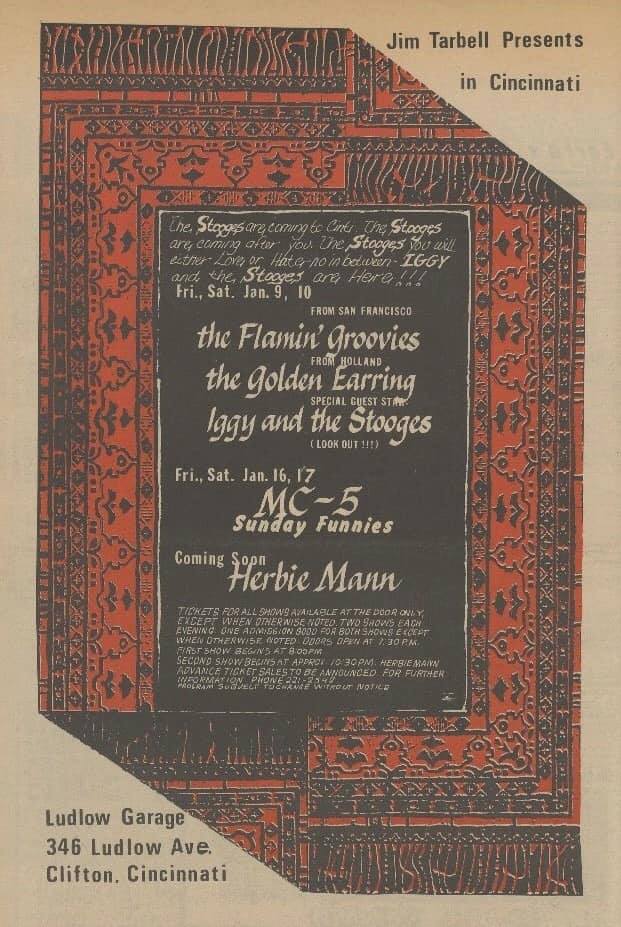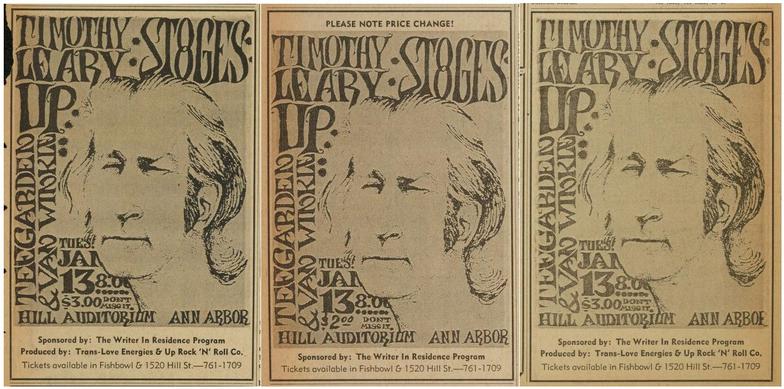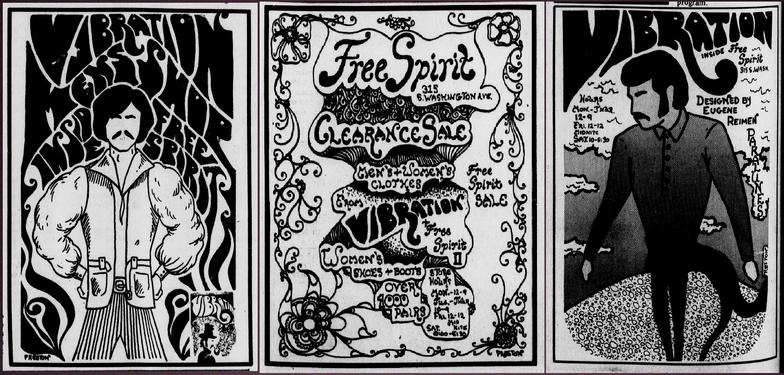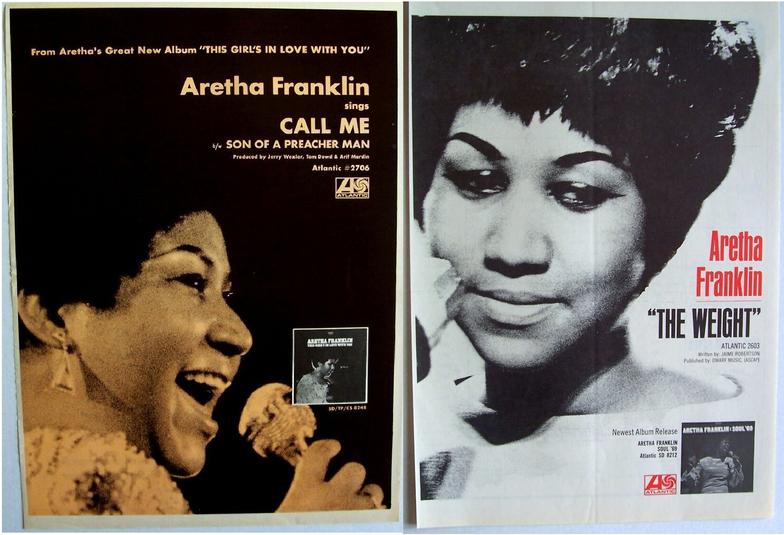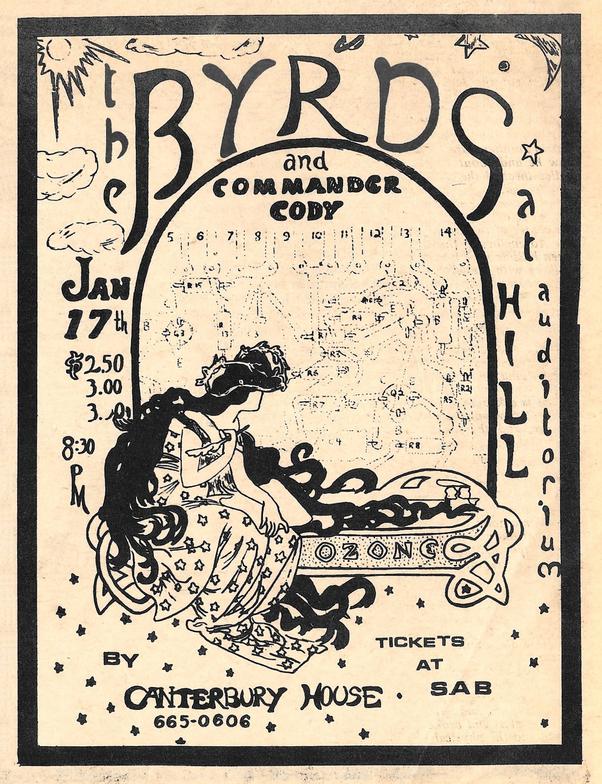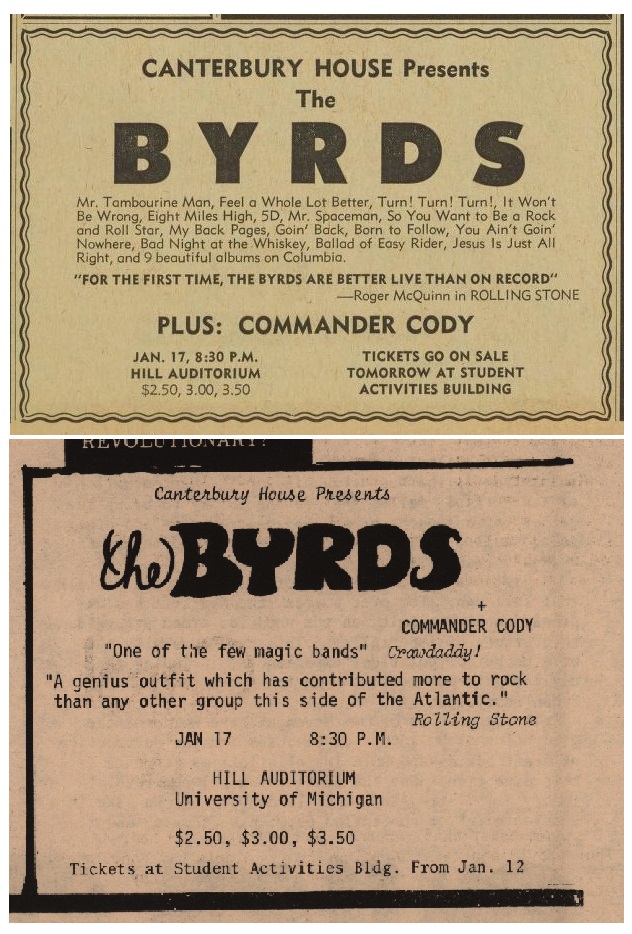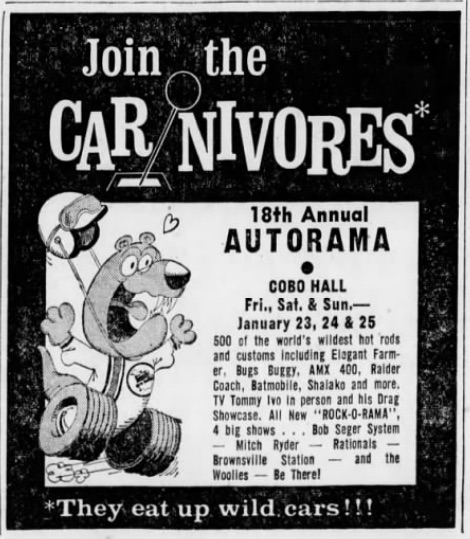Splatt Gallery
Double click here to add text.
Splatt Gallery's History of Michigan Concert Posters
Volume Six - 1970
Starting with the very first day of the New Year, the very first day of the new decade, the MC5 played a show at the Saginaw Civic Center in Saginaw, Michigan, January 1, 1970. The show was recorded and has been the source of numerous bootlegs. The recording is unique in that it captures a rare cover of “Fire of Love”, by Jody Reynolds on, as Rob Tyner points out, the Demon label.
The MC5 – Fire of Love (live in Saginaw) (01/01/70)
https://www.youtube.com/watch?v=d0iPovg4EmI
************************************************************
Two of the many bootleg releases of the MC5 at the Saginaw Civic Center in Saginaw, Michigan, January 1, 1970.
Full-page comic from the January 2, 1970 issue of The Berkeley Tribe newspaper in Berkeley, California by Carl Lundgren.
Illustration by Al Shamie (Bad Dog) that accompanied a story about the Chicago 7 conspiracy trial, published in the January 8, 1970 issue of the Fifth Estate newspaper in Detroit, Michigan.
Illustration by Al Shamie (Bad Dog), copyright 1970 by “Grand Dude Enterprises”.
Another strangely-themed show in Ann Arbor, Michigan, January 9, 1970 with the Saginaw band, Stew along with Lovelight and Floating Opera on this ad by an unknown artist.
Poster by an unknown artist for the Palladium, starting its third month of operation in Birmingham, Michigan, January 9-10, 1970.
The James Gang, who had been born at the Grande Ballroom in Detroit (as a three-piece, as earlier described) had become nearly adopted as a Michigan band, playing at least 13 shows in the state in 1969. But there was a long eight-month absence following their shows in November, part of the reason is that they went into the studio that month to record their second album, but they were also still performing two to three shows every week, and extensively, just not in Michigan.
This poster from their January 9-10, 1970 shows in Dayton, Ohio, is a classic, with a great layout, an opening band called Balderdash, and the new name for what had been one of the Hullabaloo chain clubs, now called Papalilski’s.
Plus, we can take an advance listen to the new album, which will come out in July, 1970.
The James Gang – Funk 49 (1970)
https://www.youtube.com/watch?v=U_qHU_6Ofc0
We’ve always thought that the posters for the Ludlow Garage in Cincinnati, Ohio, looked like Persian rugs and now we know why. Promoter Jim Tarbell, who opened The Garage in 1969, offered Persian rugs for sale to concert goers for floor seating in the club, you could have your name put on them and keep them at the club for future shows.
Both The Stooges and The MC5 made the trip to Cincinnati to play at the Ludlow Garage in January, 1970, with The Stooges appearing on the 9th and 10th, and The MC5 the following weekend.
A second poster for the shows at the Ludlow Garage in Cincinnati, Ohio, in January 1970, featuring appearances by both the Stooges and the MC5.
As we have previously noted, the posters for the Ludlow Garage looked like Persian rugs because promoter Jim Tarbell, who opened The Garage in 1969, offered Persian rugs for sale to concert goers for floor seating in the club, you could have your name put on them and keep them at the club for future shows.
This poster is unique by having the corners of the rug folded over, for a nice touch, and it does go on about the upcoming Stooges show:
“The Stooges are coming to Cinci. The Stooges are coming after you. The Stooges you will either Love or Hate – no in between – IGGY and the Stooges are Here !!! (Look Out !!!)”
First known poster by an artist named Bryan Clark (sp?) for The Borderline in Monroe, Michigan, January 10, 1970.
The Yippies sponsored a benefit concert to raise legal defense funds for John Sinclair, now in his sixth month of incarceration. The event brought Timothy Leary to Hill Auditorium, January 13, 1970, his first visit back to Ann Arbor since1967. Teegarden & Van Winkle, UP, and The Stooges provided “extremely amplified sound”.
Through the network of underground newspapers, Sinclair’s case was well known across the country and plans were being made for a nation-wide “Free John” event to be held on January 24th.
Poster by Al Shamie (Bad Dog).
Newsprint versions of Al Shamie’s poster for Timothy Leary, Stooges, UP, and Teegarden & Van Winkle in Ann Arbor, Michigan on January 13, 1970.
A couple of dudes by Dennis Preston in ads for the Vibration clothing store in Lansing, Michigan from early January 1970 issues of the State News newspaper.
A photo of the large banner at the final performance of Diana Ross & the Supremes, at the Frontier Hotel in Las Vegas, Nevada on January 14, 1970. It also shows the four women, as the concert served as the introduction of Ross’ replacement Jean Terrell. Ed Sullivan sent a telegram which read “As of tonight, one of the greatest attractions of the 60s becomes two of the greatest attractions of the 70s.”
A live album, titled “Farewell” was recorded over several nights during the Frontier engagement and was released in April 1970. A detailed track-by-track review can be found in the link below, and the entire album can be heard, also linked below.
https://dianarossproject.wordpress.com/2016/06/11/farewell-1970/
Diana Ross & the Supremes – Farewell (album) (1970)
https://www.youtube.com/watch?v=BCO1Mxjg6nY&list=PLQ8oopDGHUmMpF99vBKtU7dtRJG2kfJVA
An un-numbered, undated edition of the Ann Arbor Argus newspaper in Ann Arbor, Michigan with a cover by Gary Grimshaw and an events calendar that starts on January 14, 1970, that puts it in between the last issue of Vol.1 and the first issue of Vol. 2.
On January 15, 1970, Atlantic Records released the second album by The MC5. The complete album can be heard by the link below:
MC5 – Back In The USA (album) (1970)
https://www.youtube.com/watch?v=ctJxt5fbW-Q&list=PLbaroU7wiNr10RVPd8TogKpkSCq4AM0qb
SRC at the Sound Lounge in Mount Pleasant, Michigan, January 16, 1970. The Sound Lounge, which seems to have been inactive all through 1969, roared back to life with this SRC show. The flyer with the nice stone hand-lettering by an unknown artist was a departure from the style of their 1968 flyers that used generic dancing-couples clip-art (although we had to go and stick them on this collage). The new flyer also dropped the previous standard line, “across from the Sheriff’s office”.
At first glance, we would not have recognized this as Carl Lundgren’s work, but there’s the name along the side. From the January 16, 1970 issue of The Berkeley Tribe newspaper in Berkeley, California.
A full two-page spread of a magnificent work of art by Evelyn for a concert at the Rose Palace in Pasadena, California, with Alice Cooper opening for Lee Michaels and Eric Burdon & War on January 16-17, 1970.
A pair of ads for Aretha Franklin on Atlantic Records from mid-January 1970.
The management at Grandmother’s in East Lansing must have told poster artist Terry Sharbach to really pitch the food and drink sales. On the poster for Universal Family’s week of shows, January 7-16, 1970, the band practically got second billing to “A fantastic deal on two pounds of beer”, and later in the week, the band’s name got even smaller and lower, the main attraction was “Hot Dog Nite – All You Can Eat for 25 cents”.
Even Mitch Ryder, appearing on January 21, 1970, got up-staged by Hot Dog Nite, the color layout makes his name barely legible, but that hot dog sure stands out, even tempting Ryder’s trembling reach.
Newspaper ad for Grand Funk Railroad at Pirates World Amusement Center in Florida on January 16-17, 1970. The low-budget filmmaker Barry Mahon, who ran the gamut from nudie films to children’s movies filmed GRF’s set and spliced the footage into a previously-released exploitation movie called “Mondo Daytona” and called the new creation “Weekend Rebellion”.
He paired it as a double-feature with another of his films called “Musical Mutiny”, also filmed at Pirates World, that included live footage of Iron Butterfly. We will have the movie posters and the Iron Butterfly performance later, in June 1970, but for now, here is the GFR performance.
“Weekend Rebellion” was also re-released yet again, one more time, as “Get Down Grand Funk”, the poster is in the comments below.
Grand Funk Railroad – Into The Sun (live) (1970)
https://www.youtube.com/watch?v=ian5GICEx6c
Poster for the re-release of “Weekend Rebellion” with the new title “Get Down Grand Funk”.
An Epic Records ad for the “Get Down” album by Catfish that appeared in publications in February made a big deal about their performances at the Fillmore East in New York City, January 16-17, 1970, where they opened for the James Gang and Santana. Presumably, the photo is from one of those shows.
An events listing in the Detroit Free Press newspaper for John Lee Hooker at the Chess Mate in Detroit, January 16-18, 1970. Interesting that the write-up notes, “Hooker, who supposedly lives in Detroit when he isn’t traveling all over the world…”. By the time that the year 1970 comes to an end, Hooker will in fact move residency to California.
John Lee Hooker was the first Detroit musician in our story, which we began in 1949 and in the 20 years since then he had travelled far and wide, much of which we have documented with the posters for his shows.
The beginning of his career, when he was moonlighting his job at the Ford Motor Company, playing the clubs on Hastings Street and in Detroit’s Paradise Valley, circa 1943, predates the beginning of our story, one of the reasons that we chose 1949 as our starting point is that it was the year that his debut single “Boogie Chillen'” reached #1 on Billboard magazine’s “Rhythm & Blues Records” chart (renamed from the “Race Records” in that same year, by a young Billboard editor named Jerry Wexler).
For the next nine years, Hooker continued to perform primarily in Detroit, at clubs such as Basin Street and the Apex Bar. In February 1958, he made his New York City debut, performing at the famed Apollo Theater in Harlem. Following that, he made frequent appearances in NYC, particularly of note at Gerde’s Folk City, where a young folk singer named Bob Dylan opened for Hooker’s shows in April 1961.
Poster for the Borderline in Monroe, Michigan, January 17, 1970, in the same style as the previous Borderline poster by Bryan Clark.
We tallied an unofficial count of 21 rock festivals in Michigan in 1969, and the most frequent festival act, with 12 appearances was Frost, followed by MC5 and Amboy Dukes with eleven each. Right behind them, with ten festival appearances, was the Red, White & Blues Band.
Third Power had just completed recording their first, and only, album near the beginning of 1970. You may recall, we did a record round-up of albums released by Michigan rock bands at the beginning of 1969, and we’ll be doing another update soon. In the meantime, here is the lead track from the Third Power album “Believe”.
The Third Power – Gettin’ Together (1970)
https://www.youtube.com/watch?v=gURTgnaogA0
An ad for the Byrds with Commander Cody & his Lost Planet Airmen at Hill Auditorium in Ann Arbor, Michigan, January 17, 1970. The first in a series of ads for this show.
The Byrds with Commander Cody & his Lost Planet Airmen at Hill Auditorium in Ann Arbor, Michigan, January 17, 1970. The second in a series of ads for this show.
An ad for the Byrds with Commander Cody & his Lost Planet Airmen at Hill Auditorium in Ann Arbor, Michigan, January 17, 1970, with a photo that looks more like Sun Ra. The third in a series of ads for this show.
The fourth in a series of provocative ads for the Byrds with Commander Cody & his Lost Planet Airmen at Hill Auditorium in Ann Arbor, Michigan, January 17, 1970.
An ad with Catfish in Washington DC, January 9-10, 1970. He will eventually move there in 1973.
The fifth in a series of provocative ads for the Byrds with Commander Cody & his Lost Planet Airmen at Hill Auditorium in Ann Arbor, Michigan, January 17, 1970.
Yet another in a series of provocative ads in the Michigan Daily newspaper in Ann Arbor, Michigan for the Byrds with Commander Cody & his Lost Planet Airmen at Hill Auditorium on January 17, 1970. The sixth in a series of ads for this show.
Another in a series of ads in the Michigan Daily newspaper in Ann Arbor, Michigan that are quite interesting for the Byrds with Commander Cody & his Lost Planet Airmen at Hill Auditorium on January 17, 1970. The seventh in a series of ads for this show.
One more in the series of unusual ads in the Michigan Daily newspaper in Ann Arbor, Michigan for the Byrds with Commander Cody & his Lost Planet Airmen at Hill Auditorium on January 17, 1970, the eighth in a series of ads for this show, this one on the day of the show.
And yet, another ad for the Byrds with Commander Cody & his Lost Planet Airmen at Hill Auditorium in Ann Arbor, Michigan on January 17, 1970, one of the best publicized shows ever, this is the tenth one that we have posted for this show (and they have all been great, credit goes to the ad team and unknown artists at the Canterbury House).
Two more, text-only, ads for the Byrds with Commander Cody & his Lost Planet Airmen at Hill Auditorium in Ann Arbor on January 17, 1970.
A full-page London Records ad in the January 17, 1970 issue of Billboard magazine promoting new records by Al Green and Frijid Pink.
Al Green – You Say It (1970)
https://www.youtube.com/watch?v=WW1tGeof09M
Poster by an unknown artist with initials FS (?) for a free Peace Concert at Michigan State University in East Lansing, Michigan, January 18, 1970. Local band Ormandy was very active in and around the area, but they were limited in touring due to lead singer Pete Wittig’s full-time job at Sparrow Hospital, a position that allowed him conscientious objector status from the draft, a situation that he wrote about in his song, “Sparrows Corner”, which was the B-side to their lone single “Good Day”, originally released on Al Nalli’s Ann Arbor label Kasaba, later picked up by Decca Records.
The sax player in Ormandy, Tom Cartmell, later changed his name to Alto Reed and joined Bob Seger’s Silver Bullet band in 1972, when Ormandy disbanded.
Ormandy – Good Day (1970)
https://www.youtube.com/watch?v=5NOdiz0BWC8
An ad for Grand Funk Railroad at the Electric Zoo in St. Petersburg, Florida, January 18, 1970.
A nice size ad with plenty of air space in the January 21, 1970 edition of the Michigan Daily newspaper in Ann Arbor, Michigan for the second album (“A Second Coming”) by Grand Funk Railroad, which had been released in late December 1969. Interestingly, this graphic would be used for the cover art for GFR’s third album, which the band would begin recording in the upcoming months and would be released in June 1970.
The MC5 went to New York City to promote the new album and were booked at Ungano’s for four nights, January 21-24, 1970, but the band wanted to be back in Detroit to be at the epicenter of a nation-wide “Free John Sinclair Day” on the 24th, so they cut the Ungano’s gig short by a night.
As we mentioned before, Ungano’s was a friendly spot for the Detroit bands, you can see that Frost followed the MC5 with three nights at the tiny NYC club.
Universal Family, back to play out the rest of the month at Grandmother’s in East Lansing, Michigan, January 22-31, 1970, this time receiving near equal billing to the food special. Terry Sharbach drew the slices.
Probably the most unique event in the history of the Grande Ballroom occurred on January 23, 1970, when long-time MC Dave Miller got married in his beloved second home. A gorgeous flyer/wedding invitation was created by Donnie Dope, whom we haven’t seen since his last poster for Fleetwood Mac in December 1968, signing the piece with his real name, Forsyth. Music at the celebration was provided by Blues Train, Richmond, UP, and the Woolies.
An events calendar in the Detroit Free Press newspaper with an announcement of the Miller Wedding at the Grande Ballroom on January 23, 1970. Photo of Mitch Ryder for his show at the Borderline near Monroe, Michigan on Saturday, January 24th.
An ad for the Action House in Island Park, New York with Frost opening for Fleetwood Mac on January 23-24, 1970.
An ad for Commander Cody & his Lost Planet Airmen at the Canterbury House in Ann Arbor, Michigan, “Frahday, Satiday, Sunday”, January 23-25, 1970, overlaid on Chris Frayne’s picture sleeve for the “Hot Rod Lincoln” single. “Better than a bottle of cold Boone’s Farm”.
An ad for the 18th Annual Autorama at Cobo Hall in Detroit, Michigan, featuring “Rock-O-Rama” shows with the Bob Seger System, Mitch Ryder, Rationals, Brownsville Station and the Woolies, January 23-25, 1970.
Volume Six - 1970 - continues - HERE
An illustration of Mitch Ryder by Terry Sharbach for Ryder’s appearance at Grandmother’s in East Lansing on January 21, 1970.
An ad for Rare Earth back at the Dells in Haslettt, Michigan, January 21-25, 1970, where they had long held long engagements as the Sunliners.
1970 was the year that Motown Records celebrated their 10th anniversary with a year-long marketing campaign.











